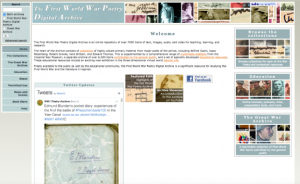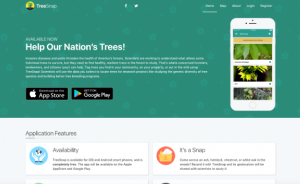Research and Education
Back to Top
|
 |
|
Smithsonian Digital Volunteers: Transcription Center
|
Social studies |
|
The Smithsonian Institute is home to a large collection of archival material in need of transcribing, including "field notes, diaries, ledgers, logbooks, currency proof sheets, photo albums, manuscripts, biodiversity specimens" and other material that may be of interest to students and scholars across disciplines. To address this need, the Institute has invited members of the general public to participate in transcribing these materials, offering an opportunity that may appeal to classroom instructors and researchers alike. Those interested in participating in transcription can browse the complete collection or by museums and archives or by theme (e.g. Art & Design, Biodiverse Planet, World Cultures). Once visitors find a project they are interested in participating in, they can view a tutorial that explains the transcription process. All items are checked by Smithsonian staff as part of the final step, offering transcribers of all experience levels the opportunity to contribute to an important research project with the peace of mind. Just a few of the collections in need of transcription include notes from arctic explorer Charles Francis Hall, letters received by the North Carolina Assistant Commissioner of the Freedman's Bureau, and the work of astronomer Henrietta Swan Leavitt. [MMB] |
|





|
|
 |
|
Hektoen International: A Journal of Medical Humanities
|
Science |
|
Launched in November 2008, Hektoen International is an open access, online journal dedicated to the intersections between medicine and the humanities. This unique journal is named in honor of pathologist Ludvig Hektoen (1863-1951), and is currently authored and edited by an international team of researchers that includes medical professionals as well as scholars in other fields. Visitors can explore articles in Hektoen in a couple of ways. On the site's homepage, visitors can check out the most recent issue of this quarterly publication, while all previous issues are available via Past Issues. Alternatively, visitors can explore articles through the Hektorama, where articles are organized by categories including Anatomy, Famous Hospitals, Moments in History, Literary Essays, and Surgery. Recent articles include an essay by medical resident and interdisciplinary scholar Katrina Genius that examines the historical and medical context of the Isenheim Altarpiece; a piece on Baghdad's first general hospital by physician Hussain Al-Sardar; and an article by medical student and neurology researcher Christopher Hemond about prosopagnosia, a condition that makes it challenging to recognize faces. Written in an accessible manner, Hektoen will appeal to a broad range of students and scholars, as well as members of the general public interested in historical and contemporary issues related to health care. [MMB] |
|





|
|
 |
|
Science Learning Center at Western Illinois University
|
Science |
|
The Science Learning Center offers a helpful collection of reference materials, outside resources, and more for K-12 science instructors and students. This site is maintained by Western Illinois University and authored by a team of biology professors, high school educators, and graduate students. This resource collection is organized by science topic/ subfield: Nature of Science, Science Safety and Techniques, Biology/ Life Sciences, Chemistry, Earth and Space Science, and Physics. Within each of these topics, visitors will find two kinds of resources. Learning Pages are accessible reference guides to key science concepts (e.g. homeostasis, energy in living things, evolution). Many of these Learning Pages also include discussion questions, classroom activities, graphic organizers, or links to related outside resources. The resource page in each topic provides links to additional outside resources that may be of interest to teachers. In addition, visitors can check out General Resources for Science, Study Strategies, and Professional Development Resources for Teachers via additional tabs. The diversity of resources on this page make the Science Learning Center a useful "one-stop shop" for science educators. [MMB] |
|





|
|
 |
|
First World War Poetry Archive
|
Social studies |
|
From the University of Oxford comes the First World War Poetry Collection, a collection of archival material and educational resources centering on the works of poets who served in World War I. Visitor may browse this collection by poet - the collection includes works by Vera Brittain, Robert Graves, Wilfred Owen, Siegfried Sassoon, and others. On the individual homepage for each poet, visitors can read a biography and explore a summary of archival material available about each poet. Alternatively, visitors may conduct a text search of archived items via a search box on the top left hand corner of the page. This collection includes photographs, letters, manuscripts, diaries, and more. Visitors are also invited to explore archives by category: Photographic Collection, Film Collection, Audio Collection, and Publications of War. Many of the materials are available courtesy of the Imperial War Museum Photographic Archive, and, collectively, they provide context to the War that may especially be of interest to those who want to incorporate this collection into a history or English classroom. Educators can also check out additional resources via the Education tab. [MMB] |
|





|
|
 |
|
 |
|
 |
|
Yale University Libraries: Free Web Resources on Religion
|
Religion |
|
Yale University Library offers this helpful collection of online resources relating to religious studies that are available for free. This collection comes courtesy of Yale Divinity School Library's Suzanne Estelle-Holmer, who has also authored a number of LibGuides about a range of topics in religious studies. Visitors can explore these resources by category, including Finding Web Resources (which features links to other web collections), Online Texts, Reference Works (highlighting a variety of online encyclopedias), and Image Resources (which include maps, art, and photography related to religion.) This extensive collection includes both comparative resources in addition to resources dedicated to specific religions. For those who would prefer to browse resources by topic rather than type may do so via the Resources by Topic tab, where resources are sorted by Biblical Studies, Church/ Denomination/Ecumenical, Early Christianity/ Patristics, Ethics, Religion and the Arts, and Theology. [MMB] |
|





|
|
 |
|
Erstwhile: A History Blog
|
Social studies |
|
Authored by a team of graduate scholars at the University of Colorado Boulder, Erstwhile is "a collaborative space in which American intellectual, cultural, labor, Native American, and environmental historians share ideas." This blog will appeal to fellow scholars of history and American studies, as well members of the general public interested in historical conversations and debates. As of this write-up, the most recent entry of Erstwhile features a collection of historian-authored resources relating to the recent white supremacist demonstration in Charlottesville, Virginia. Another recent entry provides recommendations for summer fiction readers from the blog's team. In another recent entry, Alessandra Link explores the relationship between indigenous cartographic knowledge and western colonial encounters. Visitors can browse previous blog posts by topic, including Erstwhile Interviews, Graphic Histories (which features reviews of graphic novels about historical events), and Erstwhile Interviews. [MMB] |
|





|
|























